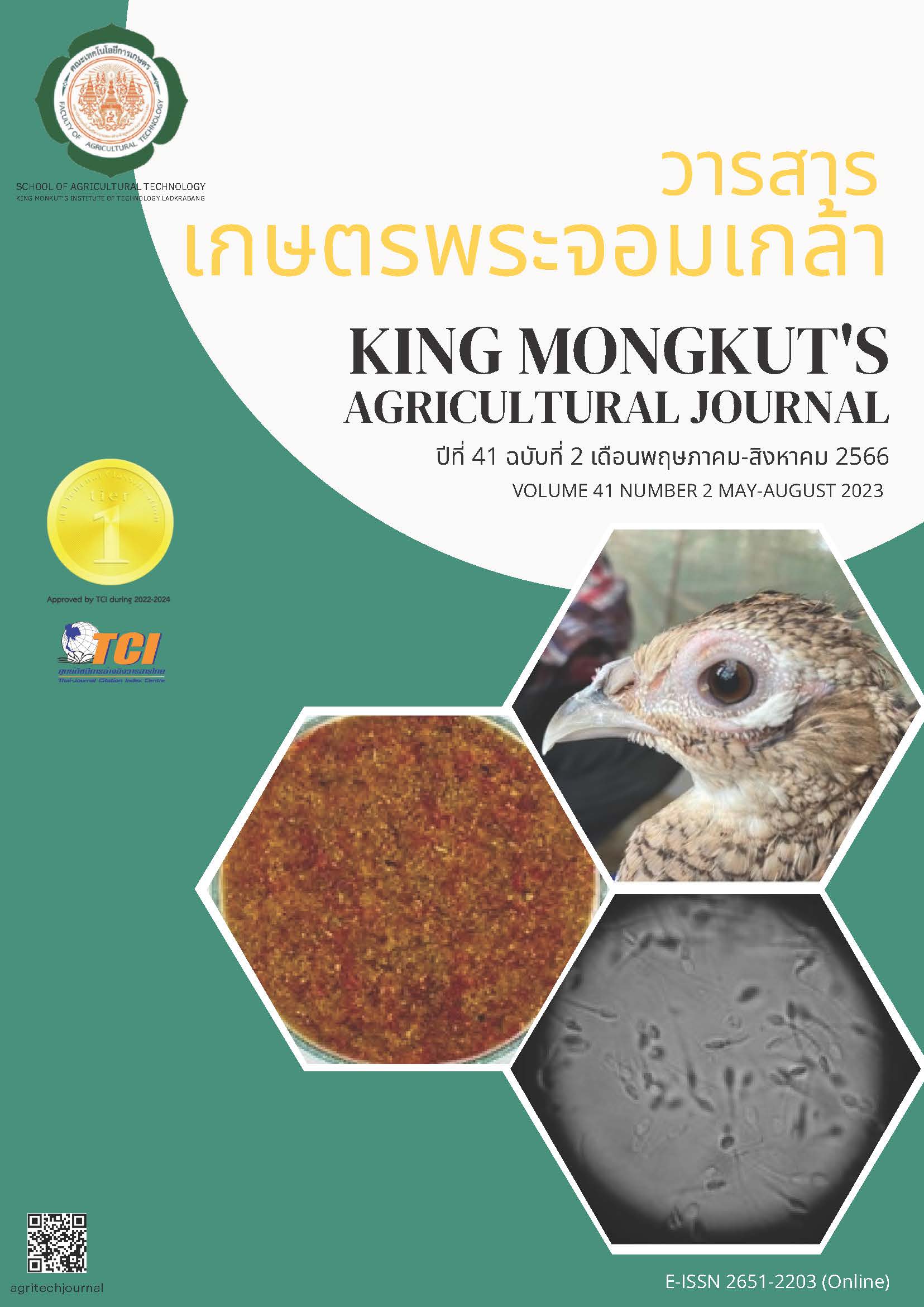การใช้เปลือกกล้วยหินหมักร่วมกับข้าวโพดหมักเป็นแหล่งอาหารหยาบสำหรับแพะนมเพศเมียหลังหย่านม
Main Article Content
บทคัดย่อ
การศึกษาคุณค่าทางโภชนะของเปลือกกล้วยหินหมักเพื่อเป็นแหล่งอาหารหยาบสำหรับแพะนมเพศเมียหลังอย่านม โดยใช้แพะนมลูกผสมซาแนน 87.5% อายุ 7 เดือน น้ำหนักเฉลี่ย 14.10±1.52 กิโลกรัม จำนวน 5 ตัว อาหารทดลองแบ่งออกเป็น 5 ทรีทเมนต์ ในการทดลองใช้แผนการทดลองแบบ 5×5 ลาตินสแควร์ โดยทรีทเมนต์ที่ 1 ข้าวโพดหมักร่วมกับเปลือกกล้วยหินหมัก 80:20 ทรีทเมนต์ที่ 2 ข้าวโพดหมักร่วมกับเปลือกกล้วยหินหมัก 60:40 ทรีทเมนต์ที่ 3 ข้าวโพดหมักร่วมกับเปลือกกล้วยหินหมัก 40:60 เปอร์เซ็นต์ ทรีทเมนต์ที่ 4 ข้าวโพดหมักร่วมกับเปลือกกล้วยหินหมัก 20:80 เปอร์เซ็นต์ และทรีทเมนต์ที่ 5 เปลือกกล้วยหินหมัก 100 เปอร์เซ็นต์ พบว่าเปลือกกล้วยหินหมักมีค่าความเป็นกรดด่าง 4.57 กรดแลกติก 3.69 เปอร์เซ็นต์ กรดบิวทิริค 0.00 เปอร์เซ็นต์ กรดอะซิติค 1.51 เปอร์เซ็นต์ วัตถุแห้ง 11.35 เปอร์เซ็นต์ โปรตีน 7.95 เปอร์เซ็นต์ เถ้า 12.5 เปอร์เซ็นต์ ปริมาณการกินได้ของอาหารหยาบ อาหารข้น และปริมาณการกินได้รวมบนฐานวัตถุแห้ง มีค่าไม่แตกต่างกันทางสถิติ ส่วนปริมาณการกินได้บนฐานเปอร์เซ็นต์น้ำหนักตัวและปริมาณการกินได้บนฐานกรัมวัตถุแห้งต่อกิโลกรัมน้ำหนักเมทาบอลิกต่อตัวต่อวัน มีค่าไม่แตกต่างกันทางสถิติ (P>0.05) เมื่อพิจารณาค่าเมแทบอไลต์ในเลือดพบว่า ค่ากลูโคสในเลือด ค่ายูเรียไนโตรเจนในเลือด และค่าเม็ดเลือดอัดแน่นที่ 0 ชั่วโมง, 4 ชั่วโมง และค่าเฉลี่ย มีค่าไม่แตกต่างกันทางสถิติ (P>0.05) ดั้งนั้นจึงสามารถใช้เปลือกกล้วยหินหมัก 100 เปอร์เซ็นต์เป็นแหล่งอาหารหยาบสำหรับแพะนมเพศเมียหลังหย่านมได้
Article Details

อนุญาตภายใต้เงื่อนไข Creative Commons Attribution-NonCommercial-NoDerivatives 4.0 International License.
วารสารเกษตรพระจอมเกล้า
เอกสารอ้างอิง
A.O.A.C. (1990). Official Methods of Analyses. 15th ed. Washington D.C: Association of Official Analytical Chemists.
Bolsen, K. K., Curtis, J. L., Lin, C. J. & Dickerson, J. L. (1990). Silage inoculant and indigenous micro flora with emphasis on
alfafa. In Biotechnology in the in feed industry proceeding of Alteoh’s sixth annual symposium. (pp. 431-443). Kentucky: Altech Technology Publication.
Cheva-Isarakul, B. (1998). Animal Nutrition. Department of Animal Science, Faculty of Agriculture Chiang Mai University.
Department of Livestock Development [DLD]. (2004). Standard for Fermented Food Plants of Animal Feed Division. Bangkok:
The Agricultural Cooperative Federation of Thailand. (in Thai).
Church, D. C. (1993). The Ruminant Animal Digestive Physiology and Nutrition. llinois: Waveland Press, lnc.
Department of Livestock Development [DLD]. (2020). Summary of data and statistics on the number of farmers – goats.
Retrieved From: https://ict.dld.go.th/webnew/images/stories/stat_web/yearly/2557/book2557/08.pdf. (in Thai).
Buxton, D. R., Mertens, D. R., Moore. K. J., Boyd, L. J., Oldfield, J. E. & Oldfield. (1995). Forage Quality for Ruminants: Plant
and Animal Considerations. Journal of The Professional Animal Scientist. 11(3), 121-131.
Fankhauser, D. B. (2012). Pour plate technique for bacterial enumeration. Retrieved from:
http://biology.clc.uc.edu/fankhauser/Labs/Microbiology/Meat_Milk/ Pour_Plate.htm. [20, April 2022].
Galyean, M. (1989). Laboratory Procedure in Animal Nutrition Research. New Mexico: Department of Animal and
Life Science, New Mexico State University.
Goering, H. K. & Van Soest, P. J. (1970). Forage fiber analyses (apparatus, reagents, procedures and some application).
Agricultural Handbook 379. Washington D.C: ARS USDA.
Kaneko, J. J. (1998). Clinical Biochemistry of Domestic Animal. 4th ed. California: Academic Oress Inc.
Laochareonsuk, S., Benjama, C. & Chanjula, P. (2002). Study on levels of Kluai Hin banana (Musa sapientum) peel meal
in Japanese quail ration. Songklanakarin Journal. 27 (2), 257-265. (in Thai).
Laorodphan, N., Likittrakulwong, W., Incharoen, T., Yammuen-art., S. & Phromnoi, S. (2021). Use of Banana Peels Fermented
with Fermentation Starter Balls and Cassava Chip on Digestibility and Blood Biochemical Contents in Meat Goats.
Journal of Agriculture. 37(3), 2565-275. (in Thai).
Laorodphan, N. & Likittrakulwong, W. (2017). Effects of banana peel silage on growth performance of crossbred Charolais.
Naresuan Phayao Journal. 10(2), 50-53. (in Thai).
Maathuis, A., Havenaar, R., He, T. & Bellmann, S. (2017). Protein digestion and quality of goat and cow milk infont formula
and guman milk under simulated infant conditions. Journal of Pediatric Gastroenterology and Nutrition.
(6), 661-666.
Mukthang, K., Tartrakoon, W., Chueaphudi, C., Hantai. P., Tongyoy, T., Likittrakulwong, W., Kassanuk, T. & Laorodphan. N. (2020).
Effects of banana peel silage on milk yields in lactating dairy goats. Khon Kaen Agriculture Journal. 48(1), 251-256.
(in Thai).
Narjisse, H., Elhonsali, M. A. & Olsen, J. D. (1995). Effects of oak (Quercus ilex) tannins on digestion and nitrogen balance
in sheep goats. Small Ruminant Research. 18(3), 201-212. (in Thai).
NRC. (1998). Nutrient Requirements of goat: Angora, dairy and meat goats in temperate and Tropical countries.
Nutrient Requirements of Domestic Animals. 15th ed. Washington, D.C: National Acedemes of Science.
Omanee, S. (2017). Evaluation of Meat Goat Raising System and Marketing Channel: A Case Study in Surat Thani Province.
(Master’s thesis). Prince of Songkla University. (in Thai).
Reed, J. D. (1995). Nutritional toxicology of tannins and related polyphenols in forage legumes. Journal of Animal Science. 73, 1516-1528.
Russell, J. B. (2002). Rumen Microbiology and Its Role in Ruminant Nutrition. New York: Cornell University Press.
Sukkasam, M., Khlibtong, J. & Seesang. S. (2014). Saba Production and Extension Need of Farmers Participation the Saba 24
Quality Inprovement Project Yala Province. In Graduate research presentation meeting Sukhothai Thammathirat
Open University 4th. Sukhothai Thammathiraj University. (in Thai).
Phonmun, T., Subanrat, T. & Chumpawadee, S. (2015). Evaluation of metabolizable energy and digestibility of agro-industrial
residues as ruminant feed. Khon Kaen Agriculture Journal. 43(1), 491-498. (in Thai).
Sakha, M., Shamesdini, M. & Mohamad-zadeh, F. (2009). Serum biochemistry values in Raini goat ofIran. Internet Journal
of Veterinary Medicine. 6(1), 1-7.
Yammuen-Art, S., Cheva-lsarakul, B., Cheva-lsarakul, B. & Promma, S. (2000). Digestibility and calculate net energy of
sweet corn stover silage in dairy cows. In The 38th Academic Conference of Kasetsart University. (pp. 163-171).
Bangkok: Kasetsart University. (in Thai).


